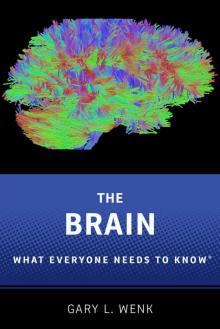


The Brain, Page 1
Gary L Wenk

THE BRAIN
WHAT EVERYONE NEEDS TO KNOW®
THE BRAIN
WHAT EVERYONE NEEDS TO KNOW®
GARY L. WENK
Oxford University Press is a department of the University of Oxford. It furthers the University’s objective of excellence in research, scholarship, and education by publishing worldwide. Oxford is a registered trademark of Oxford University Press in the UK and certain other countries.
“What Everyone Needs to Know” is a registered trademark of Oxford University Press.
Published in the United States of America by Oxford University Press 198 Madison Avenue, New York, NY 10016, United States of America.
© Oxford University Press 2017
All rights reserved. No part of this publication may be reproduced, stored in a retrieval system, or transmitted, in any form or by any means, without the prior permission in writing of Oxford University Press, or as expressly permitted by law, by license, or under terms agreed with the appropriate reproduction rights organization. Inquiries concerning reproduction outside the scope of the above should be sent to the Rights Department, Oxford University Press, at the
address above.
You must not circulate this work in any other form and you must impose this same condition on any acquirer.
Library of Congress Cataloging-in-Publication Data
Names: Wenk, Gary Lee, author.
Title: The brain : what everyone needs to know / Gary L. Wenk, PhD.
Description: New York, NY : Oxford University Press, [2017] | Series: What everyone needs to know | Includes bibliographical references and index.
Identifiers: LCCN 2016030741 (print) |LCCN 2016042204 (ebook) | ISBN 9780190603397 (pbk. : alk. paper) | ISBN 9780190603403 (hardcover : alk. paper) | ISBN 9780190603410 (UPDF) | ISBN 9780190603427 (EPUB)
Subjects: LCSH: Brain. | Neuropsychology. | Brain—Psychophysiology.
Classification: LCC QP376 .W46 2017 (print) | LCC QP376 (ebook) | DDC 612.8—dc23
LC record available at https://lccn.loc.gov/2016030741
For Jane
CONTENTS
PREFACE
Introduction
1What is a memory?
How are memories made?
Do I need to pay attention?
Why do I forget some things but not others?
How are memories recalled?
Do memories last forever?
What is amnesia?
How does the brain create a memory?
Why are patients with Alzheimer’s disease so forgetful?
How is the memory loss treated?
What does a memory look like?
How does nicotine influence brain function?
2Why do I feel this way?
What is fear?
Why are close-talkers so frightening?
What is depression?
How is depression treated?
Why do you sleep so poorly when you are depressed?
Why is depression so common?
What is the role of serotonin in depression?
What is bipolar disorder?
What is schizophrenia?
Why do schizophrenics hear voices?
Are dolphins schizophrenic?
How is schizophrenia treated?
3How do food and drugs influence my brain?
Why do plants affect the human brain?
How do we become addicted to specific foods and drugs?
Can I blame it on my parents?
Why am I addicted to caffeine?
What should I eat to feel better?
How do I stop eating so much food?
Is there a good time of day to eat?
What about carbohydrates?
What about fats?
How does obesity affect brain function and development?
Why do I like to eat?
Why do I crave fat and sugar?
Are we born destined to become obese?
How do my gut bugs keep my brain healthy?
Can a good diet make you smarter?
What about an apple a day?
Will you lose weight by eating these fruits?
Are spices good for my brain?
How do flavonoids benefit us?
Eat chocolate!
Brain toxins in the diet
4Why do I sleep and dream?
What is sleep?
Why is sleep so important?
What other daily rhythms do I experience?
What happens when I disrupt these rhythms?
How are eating and sleeping related?
How does your brain control its rhythms?
Why do I sometimes wake up paralyzed?
Why do some people act out their dreams?
What happens when I am dreaming?
Why do I sometimes dream that I am being buried alive?
Are children’s dreams different?
What is a lucid dream?
How long do dreams last?
Does it matter what time I get up or go to bed?
Does it matter who I sleep with?
Why do I need that morning cup of coffee?
Can I get too much sleep?
What if I do not get enough sleep?
What happens to sleep with aging?
5How does the brain age?
When does age-related senescence begin?
When am I going to die?
How can I live longer?
How does eating age me?
How does caloric restriction work?
Which brain region suffers the most with aging?
How can I reduce inflammation in my brain?
What is Parkinson’s disease?
How does my nervous system change as I get older?
What happens to my vision?
What happens to my hearing?
What happens to my balance?
What happens to the taste of food?
Why do things feel differently?
What can you do to slow aging?
How much should you restrict your diet?
What is the consequence of being overweight as I get older?
What can you do about your aging brain?
Do miracle cures for brain aging exist?
Why do so many people fall under the spell of charlatans?
What about Ginkgo?
What is pseudoscience?
What is the placebo effect?
6How does my brain accomplish so much?
Are near-death visits to heaven real?
How do nutrients and drugs get into my brain?
How is the cortex organized?
Why aren’t human brains bigger?
How does the cortex develop?
How do male and female brains differ?
Are bigger brains always better?
What is neurogenesis?
How do we think so fast?
What is multiple sclerosis?
Does my brain work perfectly all of the time?
What are neurotransmitters and what do they do for me?
How is my brain organized?
What happens in the front half of my brain?
How does my brain produce speech?
What happens in the back half of my brain?
Why do I daydream?
Why does the brain devote so much time to daydreaming?
What is the function of the temporal lobe?
What is a seizure?
What is a hallucination?
What is synesthesia?
What happens in the parietal lobe?
Where is my cingulate gyrus and why should I care?
What is “the little brain” and what does it do?
How does my right brain talk to my left brain?
Final thought
GLOSSARY
FURTHER READING
INDEX
PREFACE
My goals in this book are to provide the most accurate and up-to-date information possible, with the caveat that “facts” evolve and continually are being modified by new knowledge, and to present this information in a language and format accessible to a novice reader. The chapters provide answers to questions such as: How did the brain evolve? What is an emotion? What is a hallucination? How do you learn? How does your diet affect how you think and feel? What happens to your brain as you age?
Many authors begin with a discussion of neuroscience with the assumption that the reader needs to know all of the basic brain anatomy and chemistry before proceeding. I have chosen to place this chapter on neuroscience at the end of the book. In addition, I have tried to keep the jargon to a minimum and have included occasional reminders of the meanings of terms within each chapter. Should you wish to know more about some terms, I have included a Glossary at the end of the book. I have written the chapters so that they can be read in any order; I encourage you to begin with the topic that you find most interesting.
René Descartes speculated that the mind exists independent from the brain. Today, almost four centuries after Descartes’s death, we still do not fully understand how your mind emerges from the electrical and chemical processes that occur in your brain. This book introduces you to the answers that have been obtained thus far. I sincerely hope that reading this book encourages you to learn more about the wonderful organ of the mind that lives in your head. You will discover that our current understanding of the brain is incomplete. You also will discover that there are many interesting and related topics that have not been discussed in this book. My goal has been to present what I believe everyone needs to know about the brain, rather than everything that is known about the brain. In addition, I have chosen to focus upon only a few of the most common neurological diseases or mental illnesses, such as Alzheimer’s and Parkinson’s disease and depression.
During every stage of the writing, the text benefited immeasurably from the brilliant editorial suggestions of my wife, Jane, who shaped my concept of my audience and how to reach them; she skillfully converted my jargon into intelligible prose and contributed additional concepts and topics that made the book into a more comprehensive discussion of the brain. I learned to trust her judgment and insight more than my own; if there is wisdom in my writing, it has evolved under her guidance. For more than 36 years, I have been blessed to share my life with this wonderfully patient and intelligent woman who has enriched my life in countless ways. This book is dedicated to Jane.
I am deeply indebted to my editor, Joan Bossert, for asking me to submit a book on this topic in the Oxford series on What Everyone Needs To Know®. Since that day, the clarity of her advice and her unswerving encouragement have been invaluable. This book’s core derives from a course of lectures that I have given for the past 35 years to first-year psychology and biology majors. At first, I assumed that I was teaching students about the brain; ultimately, I realized that I was teaching them how to understand themselves.
INTRODUCTION
Your brain is in your head. At first glance, this seems like a dreadful place for your delicate brain to reside. Why is your brain located inside your head? It would be much safer hidden deep inside your chest. With very few exceptions, brains are always located at the front end of an animal’s feeding “tube” or digestive system that extends from the mouth to the anus. Bugs, worms, fish, birds, reptiles, dogs, and humans are simple feeding tubes with a “brain” sitting right up front, usually near the eyes, ears, and nose; thus, making it possible to find food by sight, sound, or smell and then to organize behavior so that the front end of the feeding tube can get close enough to “taste” the food and check its safety before engulfing it. Once the food is in your feeding tube, its nutrients are absorbed and become available to the cells in the rest of your body. The calories from a meal are not distributed equitably around your body. Imagine that the meal you have just finished is worth $1; the various digestive components of your feeding tube spend nearly 70 cents of your meal, with the remaining 30 pennies alone available to your brain and body to spend on its daily needs. Your brain and other organs that allow you to reproduce and move around your environment (including your muscles and bones) spend about 22 of those remaining pennies. As you can see, very few pennies are left over to spend on the other tasks in your body. These expenditures give you some idea of the priorities—thinking, sex, and movement—that billions of years of evolution have established for your brain and body (see Figure 1).
Figure 1 Your brain is the command and control center for your nervous system and body. It receives input from the sensory organs and sends output to the muscles. The human brain has the same basic structure as other mammal brains, but it is larger in relation to body size than any other mammal brain. The brain makes up about 2% of your body weight. The largest part of the human brain is the cerebrum, which is divided into two hemispheres. Underneath lies the brainstem, and behind that sits the cerebellum. The outermost layer of the cerebrum is the cerebral cortex, which consists of four lobes: the frontal lobe, the parietal lobe, the temporal lobe, and the occipital lobe. The cerebral cortex is responsible for complex thought, sensory processing, and movement. Visual processing takes place in the occipital lobe, near the back of the skull. The temporal lobe processes sound and language, and includes the hippocampus and amygdala, which play roles in memory and emotion, respectively. The parietal lobe integrates input from different senses and is important for spatial orientation and navigation.
Human brains use a lot of energy. Under normal circumstances, the brain primarily uses energy in the form of sugar: the equivalent of about 12 donuts every day! (Now you can understand why there are so many donut shops located along your morning drive to work.) Your body spends nearly a quarter of its food budget on just the brain; five times as much as most other mammals devote to their brains. Your brain uses most of this energy to organize your behavior to find food, avoid danger, and socialize with others in order to find a mate with whom to reproduce. You know one manifestation of this imperative as dating, and it requires a very large and complex brain to pull this off successfully. Eating and sex are obviously excellent ideas if your purpose is to maintain and propagate your species; fortunately, your brain does an excellent job achieving both of these tasks.
The evolution of energy-guzzling bigger brains, like yours, depended on building longer feeding tubes in order to optimize the extraction of more energy from whatever entered the front end of the feeding tube. It is not surprising then that the length of the gut, when compared across many different species, correlates with the size of the brain. As brains became larger, however, the forces of evolution shifted strategies (after all, the length of the gut can be increased only until there is insufficient room in the body to contain it); animals developed a more efficient and shorter feeding tube that relied on a high-quality, nutrient-rich diet. Therefore, today we have a gastrointestinal system that is efficient at extracting energy for itself and its two principal customers, your reproductive system and brain. Due to the high energy demands of the brain and reproductive system, however, a surprising compromise occurred during evolution: as brains became bigger, human reproductive success failed. Now you can appreciate why humans do not give birth to litters. One might predict that having a larger brain would allow greater reproductive success. After all, you would expect that animals with bigger brains would find more food, avoid predators more successfully, and find more mates. This expectation is based on the assumption that bigger brains are always smarter, but this is not so. Animals with smaller brains and bodies, such as birds, often demonstrate impressive cognitive abilities, while some large-brained species, such as whales and elephants, do not.
Brains, regardless of how big or small, complex or simple, evolved to perform one basic function: survival of the individual and the species. Survival depends upon finding
food and shelter, mating successfully, and avoiding predators; doing all of this requires the ability to learn how and where to hunt, to learn how to communicate, and to cooperate with others, while remembering what sounds and odors predict the imminent appearance of predators, as well as remembering whether it is better to fight or flee. The Spanish filmmaker Luis Buñuel famously stated that “… memory is what makes our lives. Life without memory is no life at all … Our memory is our coherence, our reason, our feeling, even our action. Without it we are nothing.” Thus, I will begin by discussing how memories are made and lost.
1
WHAT IS A MEMORY?
Your brain is never static; it continually rewires itself as you experience life and learn new things. This ability is termed plasticity. Plasticity allows you to be smart, adaptive, and better able to survive in a changing and challenging environment. This same plasticity has a dark side; it underlies your tendency to become easily addicted to drugs, foods, sex, gambling, and potentially dangerous behaviors.
What does it mean to learn something? Learning is a relatively permanent change in behavior due to an increase in knowledge or skills in response to information stored in the brain. Different parts of the brain are responsible for different types of learning. Structures within the temporal lobe, a region of the brain near your ears, are responsible for learning about specific events in your life, such as what happened yesterday or on your birthday last year, and factual knowledge, such as 6 x 7 = 42 or “what is a chair?” These events and bits of specific information are called memories. Other regions of the brain store memories related to specific skills, such as how to swing a golf club or baseball bat, or how to ride a bicycle.
Memories are not simple recordings of isolated events or bits of knowledge; they contain aspects of time and space; for example, when and where something happened, as well as an emotional component that describes how you felt when the memory was formed. The process of storing different aspects of a memory in different brain regions dedicated to specific features of the memory, such as time or emotion, allows the human brain to be very good at storing lots of memories. Thus, the components of an event get distributed to various brain regions for long-term storage. The distributed nature of memories makes storing them more efficient and protects them from being totally lost due to injury or aging; however, the distributed nature of memories also makes retrieving these stored memories much more challenging. Why do the same mechanisms that make storing memories so easy underlie the difficulty we have in retrieving them? In order to answer this question, let us begin by examining how your brain makes memories.














